 Re: CA/OR/WA 04/09–04/25, 2010 - 59 LHs, 2 LShips, 9 Fresnels, 2 Faux LHs, 4 Canadian LHs
#68579
06/20/10 07:39 PM Re: CA/OR/WA 04/09–04/25, 2010 - 59 LHs, 2 LShips, 9 Fresnels, 2 Faux LHs, 4 Canadian LHs
#68579
06/20/10 07:39 PM
|
Joined: Dec 2002
Posts: 1,964
sandy
 OP
OP
Cruise Director
|
OP

Cruise Director
Joined: Dec 2002
Posts: 1,964 |
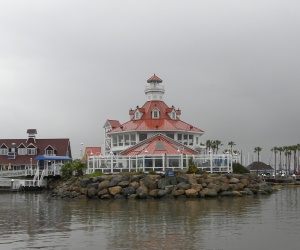 Parker’s Restaurant Faux Lighthouse 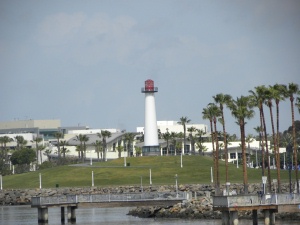 Lions (Faux) Lighthouse for Sight We then traveled by bus to Point Fermin Lighthouse, Point Vicente Lighthouse, and Point Hueneme Lighthouse: 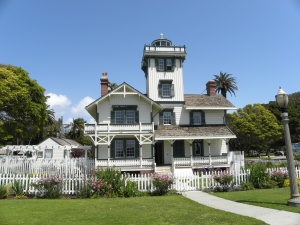 Point Fermin Lighthouse–the first navigational light into San Pedro Bay, this “Stick Style Victorian” design was used for 6 lighthouses built between 1873 and 1874. Three are still standing–East Brother in San Francisco Bay, Hereford Light in NJ, and Point Fermin. Its architectural style is simpler in design and decoration than the later high Victorian period and is characterized by gabled roofs, horizontal siding, decorative cross beams, and hand carved porch railings. 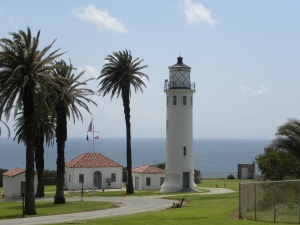 Point Vicente Lighthouse–automated in 1971, this striking station still houses Coast Guard personnel. The station has 3 keeper’s quarters, a fog signal building. Its original 3rd-Order clamshell Fresnel lens still revolves in the lantern room. Powered by a 1,000 watt bulb, the light is rated at 437,000 candle power and can be seen 20 miles at sea. 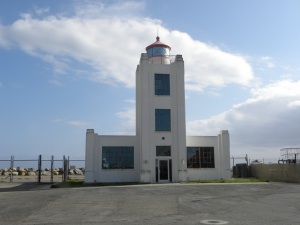 Point Hueneme Lighthouse–the original lighthouse was an ornate 2-story Victorian identical to the light at Point Fermin. This concrete “Art Moderne” structure began service in 1941 and is still active. Maintained by the Coast Guard, the light is on the grounds of the Port of Hueneme (pronounced “Wy-Nee-Mee”). We stayed in Port Hueneme, CA overnight. Following breakfast on Tuesday, we were driven to Santa Barbara where we boarded a boat for a trip to see Santa Barbara, Anacapa Island and Point Conception lighthouses: 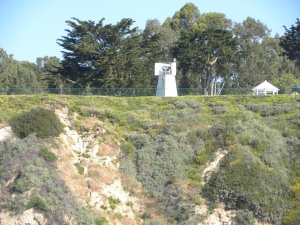 Santa Barbara Light–this site was selected so the light could serve the double purpose of a sea coast light and a harbor light. The original design was similar to most of the early west coast lighthouses–Cape Cod style with the tower projecting from the middle of the gabled roof. Destroyed by an earthquake in 1925, a temporary light exhibited from a frame tower served until the present structure was put into service in 1935. The light used from 1925 to 1977 is on display at the Point Vicente Lighthouse. 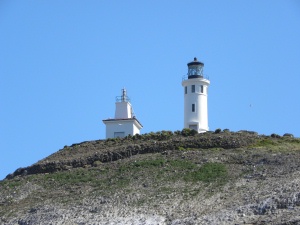 Anacapa Island Lighthouse–Anacapa is derived from the Chumash Indian word, “Eneeapha,” which means island of deception or mirage. For most of the perimeter of the island, steep sea cliffs border the water. Within these cliffs are lava tubes and air pockets that indicate the islands; volcanic origin. Construction of the station was very difficult. Started in the spring of 1930, the light from its 3rd-Order Fresnel lens was first shown in March of 1932. That lens is displayed in the Anacapa Island Visitor Center.
|
|
|
|
Entire Thread
|

 CA/OR/WA 04/09–04/25, 2010 - 59 LHs, 2 LShips, 9 Fresnels, 2 Faux LHs, 4 Canadian LHs
CA/OR/WA 04/09–04/25, 2010 - 59 LHs, 2 LShips, 9 Fresnels, 2 Faux LHs, 4 Canadian LHs
|
sandy
|
06/20/10 11:39 PM
|

 Re: CA/OR/WA 04/09–04/25, 2010 - 59 LHs, 2 LShips, 9 Fresnels, 2 Faux LHs, 4 Canadian LHs
Re: CA/OR/WA 04/09–04/25, 2010 - 59 LHs, 2 LShips, 9 Fresnels, 2 Faux LHs, 4 Canadian LHs
|
sandy
|
06/20/10 11:39 PM
|

 Re: CA/OR/WA 04/09–04/25, 2010 - 59 LHs, 2 LShips, 9 Fresnels, 2 Faux LHs, 4 Canadian LHs
Re: CA/OR/WA 04/09–04/25, 2010 - 59 LHs, 2 LShips, 9 Fresnels, 2 Faux LHs, 4 Canadian LHs
|
sandy
|
06/20/10 11:40 PM
|

 Re: CA/OR/WA 04/09–04/25, 2010 - 59 LHs, 2 LShips, 9 Fresnels, 2 Faux LHs, 4 Canadian LHs
Re: CA/OR/WA 04/09–04/25, 2010 - 59 LHs, 2 LShips, 9 Fresnels, 2 Faux LHs, 4 Canadian LHs
|
sandy
|
06/20/10 11:40 PM
|

 Re: CA/OR/WA 04/09–04/25, 2010 - 59 LHs, 2 LShips, 9 Fresnels, 2 Faux LHs, 4 Canadian LHs
Re: CA/OR/WA 04/09–04/25, 2010 - 59 LHs, 2 LShips, 9 Fresnels, 2 Faux LHs, 4 Canadian LHs
|
sandy
|
06/20/10 11:40 PM
|

 Re: CA/OR/WA 04/09–04/25, 2010 - 59 LHs, 2 LShips, 9 Fresnels, 2 Faux LHs, 4 Canadian LHs
Re: CA/OR/WA 04/09–04/25, 2010 - 59 LHs, 2 LShips, 9 Fresnels, 2 Faux LHs, 4 Canadian LHs
|
sandy
|
06/20/10 11:52 PM
|

 Re: CA/OR/WA 04/09–04/25, 2010 - 59 LHs, 2 LShips, 9 Fresnels, 2 Faux LHs, 4 Canadian LHs
Re: CA/OR/WA 04/09–04/25, 2010 - 59 LHs, 2 LShips, 9 Fresnels, 2 Faux LHs, 4 Canadian LHs
|
sandy
|
06/20/10 11:52 PM
|

 Re: CA/OR/WA 04/09–04/25, 2010 - 59 LHs, 2 LShips, 9 Fresnels, 2 Faux LHs, 4 Canadian LHs
Re: CA/OR/WA 04/09–04/25, 2010 - 59 LHs, 2 LShips, 9 Fresnels, 2 Faux LHs, 4 Canadian LHs
|
sandy
|
06/20/10 11:52 PM
|

 Re: CA/OR/WA 04/09–04/25, 2010 - 59 LHs, 2 LShips, 9 Fresnels, 2 Faux LHs, 4 Canadian LHs
Re: CA/OR/WA 04/09–04/25, 2010 - 59 LHs, 2 LShips, 9 Fresnels, 2 Faux LHs, 4 Canadian LHs
|
sandy
|
06/21/10 12:07 AM
|

 Re: CA/OR/WA 04/09–04/25, 2010 - 59 LHs, 2 LShips, 9 Fresnels, 2 Faux LHs, 4 Canadian LHs
Re: CA/OR/WA 04/09–04/25, 2010 - 59 LHs, 2 LShips, 9 Fresnels, 2 Faux LHs, 4 Canadian LHs
|
WackoPaul
|
06/21/10 02:21 AM
|

 Re: CA/OR/WA 04/09–04/25, 2010 - 59 LHs, 2 LShips, 9 Fresnels, 2 Faux LHs, 4 Canadian LHs
Re: CA/OR/WA 04/09–04/25, 2010 - 59 LHs, 2 LShips, 9 Fresnels, 2 Faux LHs, 4 Canadian LHs
|
Lorie Roe
|
06/21/10 03:50 PM
|

 Re: CA/OR/WA 04/09–04/25, 2010 - 59 LHs, 2 LShips, 9 Fresnels, 2 Faux LHs, 4 Canadian LHs
Re: CA/OR/WA 04/09–04/25, 2010 - 59 LHs, 2 LShips, 9 Fresnels, 2 Faux LHs, 4 Canadian LHs
|
kory63
|
06/21/10 04:18 PM
|

 Re: CA/OR/WA 04/09–04/25, 2010 - 59 LHs, 2 LShips, 9 Fresnels, 2 Faux LHs, 4 Canadian LHs
Re: CA/OR/WA 04/09–04/25, 2010 - 59 LHs, 2 LShips, 9 Fresnels, 2 Faux LHs, 4 Canadian LHs
|
wvlights0
|
06/21/10 07:03 PM
|

 Re: CA/OR/WA 04/09–04/25, 2010 - 59 LHs, 2 LShips, 9 Fresnels, 2 Faux LHs, 4 Canadian LHs
Re: CA/OR/WA 04/09–04/25, 2010 - 59 LHs, 2 LShips, 9 Fresnels, 2 Faux LHs, 4 Canadian LHs
|
sandy
|
06/21/10 10:41 PM
|

 Re: CA/OR/WA 04/09–04/25, 2010 - 59 LHs, 2 LShips, 9 Fresnels, 2 Faux LHs, 4 Canadian LHs
Re: CA/OR/WA 04/09–04/25, 2010 - 59 LHs, 2 LShips, 9 Fresnels, 2 Faux LHs, 4 Canadian LHs
|
MrsTLC
|
06/21/10 10:49 PM
|

 Re: CA/OR/WA 04/09–04/25, 2010 - 59 LHs, 2 LShips, 9 Fresnels, 2 Faux LHs, 4 Canadian LHs
Re: CA/OR/WA 04/09–04/25, 2010 - 59 LHs, 2 LShips, 9 Fresnels, 2 Faux LHs, 4 Canadian LHs
|
Bill and Judy
|
06/22/10 02:15 AM
|

 Re: CA/OR/WA 04/09–04/25, 2010 - 59 LHs, 2 LShips, 9 Fresnels, 2 Faux LHs, 4 Canadian LHs
Re: CA/OR/WA 04/09–04/25, 2010 - 59 LHs, 2 LShips, 9 Fresnels, 2 Faux LHs, 4 Canadian LHs
|
rscroope
|
06/22/10 06:51 PM
|

 Re: CA/OR/WA 04/09–04/25, 2010 - 59 LHs, 2 LShips, 9 Fresnels, 2 Faux LHs, 4 Canadian LHs
Re: CA/OR/WA 04/09–04/25, 2010 - 59 LHs, 2 LShips, 9 Fresnels, 2 Faux LHs, 4 Canadian LHs
|
sandy
|
06/22/10 11:49 PM
|

 Re: CA/OR/WA 04/09–04/25, 2010 - 59 LHs, 2 LShips, 9 Fresnels, 2 Faux LHs, 4 Canadian LHs
Re: CA/OR/WA 04/09–04/25, 2010 - 59 LHs, 2 LShips, 9 Fresnels, 2 Faux LHs, 4 Canadian LHs
|
Lighthouse Loon
|
06/23/10 12:06 AM
|

 Re: CA/OR/WA 04/09–04/25, 2010 - 59 LHs, 2 LShips, 9 Fresnels, 2 Faux LHs, 4 Canadian LHs
Re: CA/OR/WA 04/09–04/25, 2010 - 59 LHs, 2 LShips, 9 Fresnels, 2 Faux LHs, 4 Canadian LHs
|
sandy
|
06/30/10 06:59 AM
|

 Re: CA/OR/WA 04/09–04/25, 2010 - 59 LHs, 2 LShips, 9 Fresnels, 2 Faux LHs, 4 Canadian LHs
Re: CA/OR/WA 04/09–04/25, 2010 - 59 LHs, 2 LShips, 9 Fresnels, 2 Faux LHs, 4 Canadian LHs
|
sandy
|
06/30/10 07:00 AM
|

 Re: CA/OR/WA 04/09–04/25, 2010 - 59 LHs, 2 LShips, 9 Fresnels, 2 Faux LHs, 4 Canadian LHs
Re: CA/OR/WA 04/09–04/25, 2010 - 59 LHs, 2 LShips, 9 Fresnels, 2 Faux LHs, 4 Canadian LHs
|
WackoPaul
|
06/30/10 03:50 PM
|

 Re: CA/OR/WA 04/09–04/25, 2010 - 59 LHs, 2 LShips, 9 Fresnels, 2 Faux LHs, 4 Canadian LHs
Re: CA/OR/WA 04/09–04/25, 2010 - 59 LHs, 2 LShips, 9 Fresnels, 2 Faux LHs, 4 Canadian LHs
|
rscroope
|
06/30/10 07:57 PM
|

 Re: CA/OR/WA 04/09–04/25, 2010 - 59 LHs, 2 LShips, 9 Fresnels, 2 Faux LHs, 4 Canadian LHs
Re: CA/OR/WA 04/09–04/25, 2010 - 59 LHs, 2 LShips, 9 Fresnels, 2 Faux LHs, 4 Canadian LHs
|
wvlights0
|
07/01/10 02:45 AM
|

 Re: CA/OR/WA 04/09–04/25, 2010 - 59 LHs, 2 LShips, 9 Fresnels, 2 Faux LHs, 4 Canadian LHs
Re: CA/OR/WA 04/09–04/25, 2010 - 59 LHs, 2 LShips, 9 Fresnels, 2 Faux LHs, 4 Canadian LHs
|
sandy
|
07/01/10 03:53 AM
|

 Re: CA/OR/WA 04/09–04/25, 2010 - 59 LHs, 2 LShips, 9 Fresnels, 2 Faux LHs, 4 Canadian LHs
Re: CA/OR/WA 04/09–04/25, 2010 - 59 LHs, 2 LShips, 9 Fresnels, 2 Faux LHs, 4 Canadian LHs
|
fra02441
|
07/01/10 02:04 PM
|

 Re: CA/OR/WA 04/09–04/25, 2010 - 59 LHs, 2 LShips, 9 Fresnels, 2 Faux LHs, 4 Canadian LHs
Re: CA/OR/WA 04/09–04/25, 2010 - 59 LHs, 2 LShips, 9 Fresnels, 2 Faux LHs, 4 Canadian LHs
|
sandy
|
07/02/10 07:06 AM
|

 Re: CA/OR/WA 04/09–04/25, 2010 - 59 LHs, 2 LShips, 9 Fresnels, 2 Faux LHs, 4 Canadian LHs
Re: CA/OR/WA 04/09–04/25, 2010 - 59 LHs, 2 LShips, 9 Fresnels, 2 Faux LHs, 4 Canadian LHs
|
sandy
|
07/11/10 05:52 AM
|

 Re: CA/OR/WA 04/09–04/25, 2010 - 59 LHs, 2 LShips, 9 Fresnels, 2 Faux LHs, 4 Canadian LHs
Re: CA/OR/WA 04/09–04/25, 2010 - 59 LHs, 2 LShips, 9 Fresnels, 2 Faux LHs, 4 Canadian LHs
|
sandy
|
07/11/10 05:52 AM
|

 Re: CA/OR/WA 04/09–04/25, 2010 - 59 LHs, 2 LShips, 9 Fresnels, 2 Faux LHs, 4 Canadian LHs
Re: CA/OR/WA 04/09–04/25, 2010 - 59 LHs, 2 LShips, 9 Fresnels, 2 Faux LHs, 4 Canadian LHs
|
sandy
|
07/11/10 05:52 AM
|

 Re: CA/OR/WA 04/09–04/25, 2010 - 59 LHs, 2 LShips, 9 Fresnels, 2 Faux LHs, 4 Canadian LHs
Re: CA/OR/WA 04/09–04/25, 2010 - 59 LHs, 2 LShips, 9 Fresnels, 2 Faux LHs, 4 Canadian LHs
|
WackoPaul
|
07/11/10 04:44 PM
|
|
|
|
Forums39
Topics16,978
Posts184,640
Members2,579
| |
Most Online10,155
Jan 14th, 2020
|
|
|
0 registered members (),
1,356
guests, and 3
spiders. |
|
Key:
Admin,
Global Mod,
Mod
|
|
|

